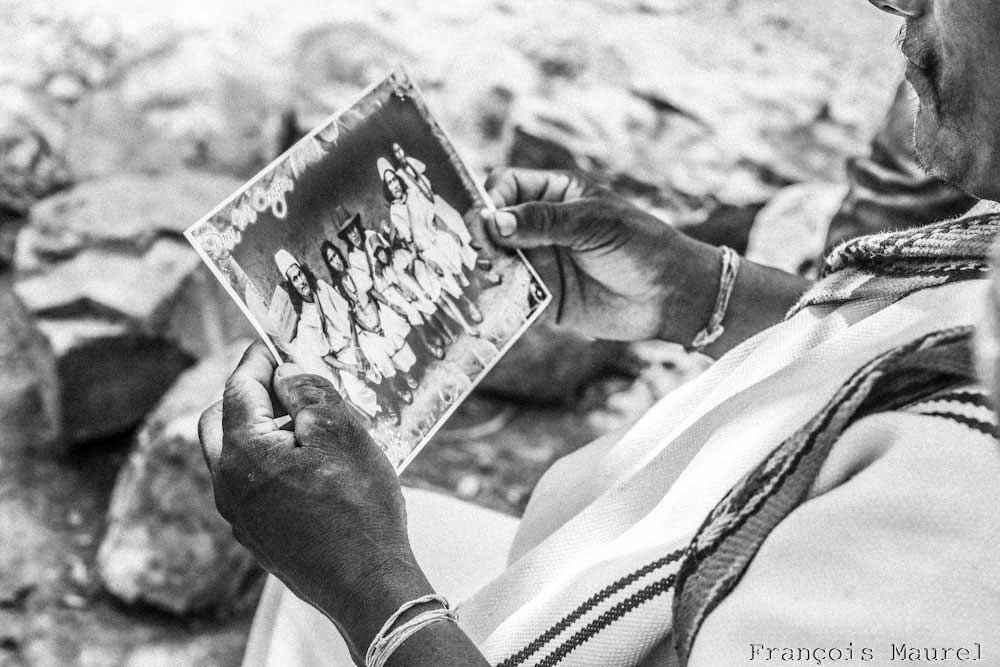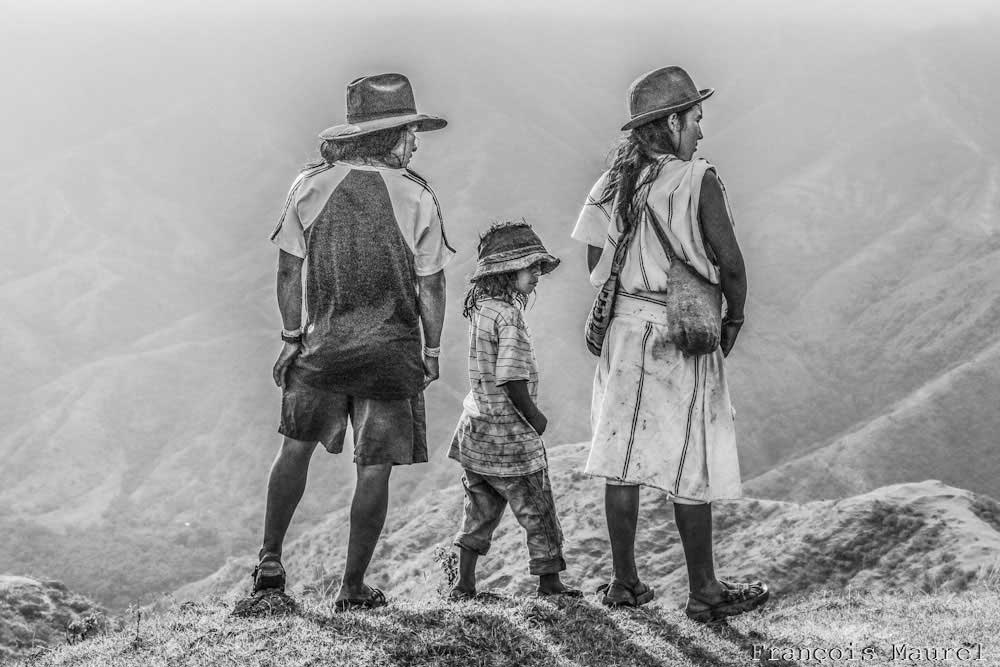«Hermanito» is a photographic life experience in the heart of a family of the Arhuacos tribe in Colombia. I have been working for 10 years on the peoples of the world, on our changing societies.
I try to integrate and share the intimate life of certain social classes of the world, the Favela de Rio de Janeiro night in 2013for 3 months and several trips, through the castes of the Untouchables in India in the south west during 2 month, the intimate life of the great South African photographer Santu Mofokeng, through the nomads of the sea «Vezo», all without a plan.

This time it is in Colombia, in a family of 11 children that I could ask an intimate glance of the interior «INSIDE OUT»; a look from the inside by and for the outside.A way and an atypical approach that makes it possible not to come looking for something prepared, and especially not to overcome prejudices.
Their history is in the process of upheaval and mutation, like that of our current societies. They will movefrom total isolation for centuries to the acculturation that has begun.The Human project «Hermanito» to go live with the other in a spirit of adventure begins in November 2017 on 8. On this first trip of 2 months, Colombia is going to live a radical social and economic change. my feeling.
How do the sons and grandsons of these Aboriginal peoples of our new era live the transformation of ancestral and mythological culture towards a society of cultural and cultural leisure?
What impact do these mutations have on the cultural and spiritual scene and on the safeguarding of their sacred area?
Do these changes leave room for an alternative mutation? Can the economic emergence of a large country like Colombia be conducive to the production of controlled protection of this universal historical heritage of indigenous peoples.
These are the questions that long-shot photos, with an artistic vision of the beautiful in its natural environment will debate. Far from the look of ethnologist who seeks only the differences between peoples, far from the witness and the voyeurism that lives not the action and no longer take the time to feel and feel, I will try as usual to try to express myself in the slowness and duration to grasp the subtleties to find a way, an intimate and unique vision. In film film and in digital.
It is above all in a spirit of adventure and patience as on my other works, without plan and without preparation that I will live again with them in the year 2018 in March / April and in 2019. Collect moments of Life demands commitment and total involvement.

The confidence that this family brings to me by opening me their intimacy, will allow an exceptional inheritance under the prism of the Image, a Heritage common to all, of a mythical people descending from the Mayans and Tayrona Indians, a cultural wealth without equivalence.
A tribute to our purest Universality. Why not a tool for their protection, a tool to raise awareness through the image of the preservation of their eco system and their wealth of life. I will finish with a sentence of Gandhi:
Everything you do will be ridiculous, but it is essential that you do it
Presentation :
«Hermanito» This is the nickname given to us by the Arhuacos Indians of Sierra Nevada Santa Marta in Colombia. To us the peoples of the world, consumers and modern man. The Arhuacos are an indigenous ethnic group of Colombia. This people is concentrated in the north of the Sierra Nevada de Santa Marta, mountainous mountain range of the Andes. The Arhuacos come from the Tayrona culture. Their language, Arhuaco, belongs to the descent of the Chibchan languages, from the family of Amerindian languages. The Arhuacos would include a number of 35,000 people. Their structure is complex. Although dispersed, the tribe has a total of 42 distinct communities, but divided into 22 sections:
The Central Zone: Nabusimake (capital of the Arhuacos Nation), Yechikin and Busin,
Western Zone: Serankua, Windiwameina, Singunei,
Southern Zone: Zigta, Yeurwa, Gumuke, Yeiwin, Seiarukwingumu, Buyuaguenka and Simonorwa,
The Southeast Zone: Wirwa, Yugaka, Karwa, Eastern Zone: Sogroma, Donachwi, Timaka, Aruamake, Seinimin and Izrwa.
Synopsis
Since 2007, the Sierra Nevada de Santa Marta (SNSM) region in northeastern Colombia has been the subject of a vast policy of territorial recovery undertaken during the first term of President Álvaro Uribe Vélez (2002-2006 ) in the context of its Democratic Security Policy. Behind this facade under construction, another story is emerging, less poetic.
Sierra Nevada now represents a strategic region for the development of the country, not only because of its geographical location – near the Atlantic Ocean it constitutes a vast corridor of circulation from the Venezuelan border, to the east, until in Urabá, near the Panamanian border, in the west of the country – but also in terms of its rich biodiversity and innumerable natural resources. After the military reconquest of the area in 2004, a so-called «social recovery» to integrate this marginalized region into the national territory. Also, behind the socio-cultural and environmental ambitions displayed at the time of the launch of the program, does the Colombian government allow today to express other «appetites» ?, which reveal the economic ambitions of the State to with regard to the region. This area occupies a position too strategic from the point of view of economic development so that the majority of its territory is entrusted to the Indians.

Since the arrival of President Juan Manuel Santos at the head of the government, the ads are multiplying to foment the tourism and agro-industrial potential of the region. Faced with this announced opening up of development, some indigenous villages built in particularly strategic areas are now threatened by the economic interests clashing for control of the territory.
SIERRA NEVADA DE SANTA MARTA is about 17,000 km2. On this vast surface, cohabit a population of a great diversity and juxtaposes a multiplicity of jurisdictions, administrative, political and environmental. In addition to the four indigenous communities, Kogi, Arhuaco, Wiwa and Kankuamo, original peoples of the SNSM.
Sierra Nevada was declared a UNESCO Biosphere Reserve in 1979 by UNESCO. Resolution No. 002 of January 17, 2016, states that «the ban on entry of tourists into the reserve and indigenous territory of the Arhuaco people of the Sierra Nevada of Santa Marta», was taken by the Arhuaco Guard of the Sierra Nevada of Santa Marta. The indigenous traditional authorities of the Arhuaco people in the exercise of the powers conferred on the original law, the constitution and other relevant norms, consider as the tourist trade and the presence of members outside the Arhuaco people, especially the activities who contribute to religious indoctrination or other non- traditional uses and customs, has been considered detrimental to the cultural, social and economic integrity of communities and their members, which has long been banned in Arhuaco territory .

The highest point of the Sierra Nevada massif is more than 5,000 meters high. Emerging from the Caribbean coast, the lowlands are covered with tropical forests and become savannas and fog forests at altitude. For Indians, Sierra Nevada is the center of the world. It is surrounded by an invisible ‘black line’ that connects the sacred sites of their ancestors and delineates their territory. The Indians of the Sierra are self-styled «big brothers» and consider that they display a mystical wisdom and understanding, superior to those of other peoples whom they call their ‘little brothers’.
The big brothers believe that it is their responsibility to maintain the equilibrium of the universe. When there are hurricanes, periods of drought or famine in the world, they say they are responsible for the failure of man to maintain the harmony of the world. The equilibrium is established by making offerings to the sacred sites to return to the earth what has been taken from it.
Their spiritual leaders are called Mamo. They are responsible for maintaining the natural order of the world through singing, meditation and offering rites. Mamo’s learning begins at an early age and continues until he is about 18 years old. The young man is taken to the heights of the mountains where he learns to meditate on the natural and spiritual world. In our Western culture, the Mamo would be both a priest, a teacher and a doctor.

The coca
The coca leaf plays a central role in the daily life of the Indians of Sierra Nevada and is used in offerings and ceremonies. Each man carries a small purse filled with coca leaves that he chews to create a slight stimulating effect. When two men meet, they exchange a handful of leaves as a sign of mutual respect. The man also carries a hollowed-out gourd – the ‘poporo’ – which contains a powder of crushed shells. He uses a stick to pick up some of this powder and mix it with the coke ball that is in his mouth – the alkalinity of the shells causes a reaction with the coca by stimulating its active ingredients. The surplus of powder is fixed to the opening of the poporo forming with time a thick collar. Coca is also grown by non-Indian settlers to be turned into cocaine. Colombia has long been described as a global platform for cocaine and its production has had devastating consequences for Indians.
The lower flanks of the Sierra are occupied by settlers who grow coca to fuel drug trafficking, which finances much of the armed conflict between the guerrillas and the paramilitaries. Despite their peaceful nature, Indians have frequently been caught between the army and armed clandestine groups. Many of them have been killed or forced to flee the conflict on their land.
Water
Water is very precious for the Indians who fiercely oppose the existing hydroelectric dams in the area as well as new projects. Dams interfere with the natural cycle of Sierra waters and threaten the cultures and livelihoods of Indians. Development projects and large landowners make it increasingly difficult for Indians to move to their ancestral territory and prevent them from making offerings to maintain the balance of the world. It is in this current context, that I will try to realize this photographic testimony in the long term to follow the evolutions, a work in the long run.


























